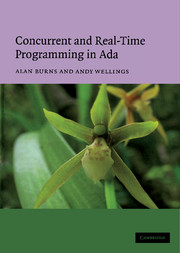The major difficulties associated with concurrent programming arise from process interaction. Rarely are processes as independent of one another as they were in the simple example of the previous chapter. One of the main objectives of embedded systems design is to specify those activities that should be represented as processes (that is, active entities and servers), and those that are more accurately represented as protected entities (that is, resources). It is also critically important to indicate the nature of the interfaces between these concurrent objects. This chapter reviews several historically significant inter-process communication primitives: shared variables, semaphores, monitors and message passing. Before considering language primitives, however, it is necessary to discuss the inherent properties of inter-process communication. This discussion will be structured using the following headings:
These are the themes that have influenced the design of the Ada tasking model.
As this model directly represents active and protected entities, there are two main forms of communication between active tasks:
direct – task-to-task communication;
indirect – communication via a protected resource.
Both these models are appropriate in Ada programs. In the following sections, however, we start by considering the problems of communicating indirectly by the use of only passive entities.
Data communication
The partitioning of a system into tasks invariably leads to the requirement that these tasks exchange data in order for the system to function correctly. For example, a device driver (a process with sole control over an external device) needs to receive requests from other processes and return data if appropriate.
